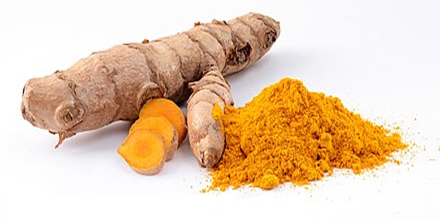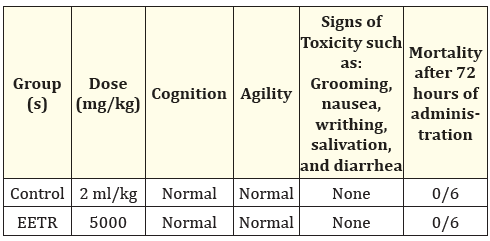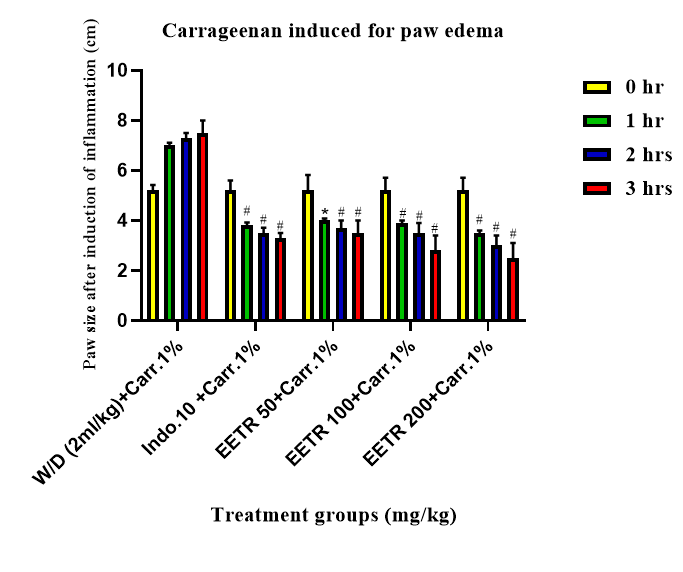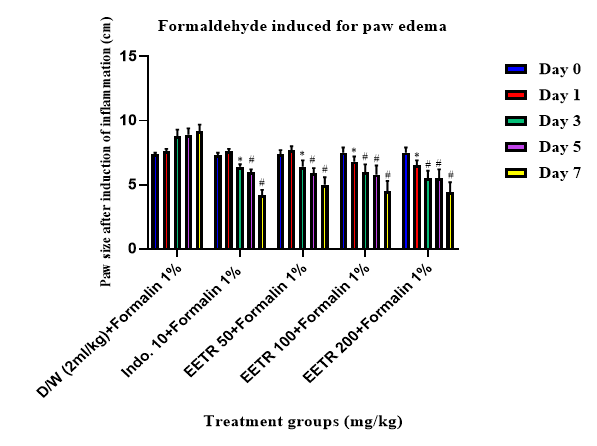Obaro Peter Onezeyi* and Obaro-Onezeyi Osasere Enohor
Department of Science Laboratory Technology (Pharmacology/Physiology and Biological Science Techniques), Faculty of Life Sciences, University of Benin, Benin City, Edo State, Nigeria
*Corresponding Author: Obaro Peter Onezeyi, Department of Science Laboratory Technology (Pharmacology/Physiology and Biological Science Techniques), Faculty of Life Sciences, University of Benin, Benin City, Edo State, Nigeria.
Received:September 06, 2024; Published: September 12, 2024
Citation: Obaro Peter Onezeyi., et al. “Acute Toxicity and Anti-Inflammatory Effect of Turmeric Rhizome (Curcuma longa) on Induced Inflammatory Models Using Albino Wistar Rats". Acta Scientific Pharmaceutical Sciences 8.10 (2024):05-11.
The world's oldest system of health care is the application of herbal medicine and has been used in all cultures. Up to 10% of people worldwide are affected by the chronic condition known as inflammation and arthritis. Arthritis basically means inflammation of the joints. All conditions that have an impact on the joints are commonly referred to as having arthritis. These illnesses are included in the larger category of rheumatic diseases. Arthritic pain is likely the most well-known type of pain in both primary and secondary care. When joints become inflamed, they can cause stiffness, warmth, swelling, redness, and discomfort. Gout, rheumatoid arthritis, osteoarthritis, psoriatic arthritis, lupus, and spondylitis are only a few of the many kinds of arthritis. This study was aim to investigate the acute toxicity and effect of the ethanol extract of Curcuma longa (Turmeric rhizome) in the treatment of inflammations induced in albino rats. The acute toxicity effect and anti-inflammatory studies of the ethanol extract of Curcuma longa (Turmeric rhizome) (acute and chronic induced inflammations) in albino rats were carried out using standard procedures. Results from the acute toxicity study revealed that the LD50 was more than 5000 mg/kg. The anti-inflammatory study revealed dose dependent anti-inflammatory activity of the extract in both acute and chronic induced inflammations. It is concluded that the ethanol extract of Curcuma longa (Turmeric rhizome), displayed anti-inflammatory activity and should be tried clinically on patients with arthritis and inflammations.
Keywords: Herbal Medicine; Inflammation; Arthritis; Acute Toxicity; Curcuma longa; Anti-Inflammatory Study
Arthritis basically means inflammation of the joints [1]. Even so, joint inflammatory disease is more like a clinical signs than a precise diagnosis. All conditions that have an impact on the joints are commonly referred to as having arthritis. These illnesses are included in the larger category of rheumatic diseases. Arthritic pain is likely the most well-known type of pain in both primary and secondary care [2]. Arthritis is a condition in which a joint becomes inflamed. When joints become inflamed, they can cause stiffness, warmth, swelling, redness, and discomfort. Gout, rheumatoid arthritis, osteoarthritis, psoriatic arthritis, lupus, and spondylitis are only a few of the many kinds of arthritis [2].
The most common types of arthritis include Osteoarthritis arthritis, Rheumatoid Arthritis , Psoriatic Arthritis and Gout. The various causes of arthritis usually are Environmental factors for certain kinds of arthritis, there are therapies that can help lessen symptoms and prevent further joint damage. Medicines such as pain relievers (painkillers), anti-inflammatory prescriptions, or anti-disease medications are among the options for treatment known as disease-modifying anti-rheumatic drugs, or DMARDs, which are used to treat inflammatory types of arthritis such as juvenile idiopathic arthritis, anky-losing spondylitis, and rheumatoid arthritis [3].
Curcuma longa or turmeric is a perennial herb and member of the Zingiberaceae (ginger) family and is cultivated extensively in Asia mostly in India and China. The rhizome, the portion of the plant used medicinally, yields a yellow powder. Dried Curcuma longa is the source of turmeric, the ingredient that gives curry powder its characteristic yellow color. It has many names such as Curcum in the Arab region, Indian saffron, Haridra (Sanskrit, Ayurvedic), Jianghuang (yellow ginger in Chinese), Kyoo or Ukon Japanese [4].
Turmeric has been used in Asian cuisines for both its flavor and color and in the Chinese and Ayurvedic medicine particularly as an anti-inflammatory and for the treatment of jaundice, menstrual difficulties, hematuria, hemorrhage, and colic. It is official in the Pharmacopoeia of China as well as in other Asian countries such as Japan and Korea and its usage covers a wide range of health indications [5].
Turmeric contains protein 6.3%, fat 5.1%, minerals 3.5%, carbohydrates 69.4% and moisture 13.1%. The essential oil 5.8% obtained by steam distillation of rhizomes has a-phellandrene 1%, sabinene 0.6%, cineol 1%, borneol 0.5%, zingiberene 25% and sesquiterpines 53% [3].
The Curcuma longa (Turmeric rhizome) were purchased in December 2023 from Ovbiogie market in Ovia South, Benin City, Edo state, Nigeria. The turmeric rhizome was authenticated by Prof. H.A. Akinnibosun a taxonomist in the Department of Plant Biology and Biotechnology, Faculty of Life Sciences, University of Benin, Benin City, where a herbarium specimen number UBH-P602 of the plant was deposited. The turmeric rhizome were first washed, cut into smaller pieces and air-dried at room temperature after purchase for 2 weeks then dried in an oven at 400C for 1 hour. The dried sample was then reduced to fine powder using an electric milling machine and stored in air tight containers for future use [6].

Figure 1: Turmeric rhizome and powder.
Five hundred gram (500 g) of the powder was extracted with ethanol solvent using cold extraction method. The ground powdered leave was weighed and placed in a glass jar. 2.5 liters of ethanol solvent was poured into the glass jar to make ¾. The solution was macerated and then shakes vigorously as often as possible. After 72 hours the solution was macerated and filters using a cheese-cloth. The resulting extract was concentrated to dryness using an oven at 400C. The percentage yield was calculated with reference to the dried powder used.
Twenty grams (20 g) obtained from the extract were dissolved in 100 ml of water from a distilled source daily to obtain a stock solution (200 mg/ml) from which dilutions were made and calculated doses administered to the animals during the experimental procedures [7].
Ethanol solvent, chloroform (supplied by Fharmatrends Nigeria Ltd), Sodium Chloride all of analytical standards.
Indomethacin, were of pure samples and pharmaceutical standards.
Acute toxicity study was carried out by methods of OECD (Organization of economic co-operation development), 2008a guidelines. Six (6) mice (3 males and 3 females) were administered 5, 000 mg/kg per body weight of the extract and observed for 72 hours for possible signs of toxicity, mortality or morbidity.
The animal house of the Phytomedicine unit in the Department of Plant Biology and Biotechnology, University of Benin, provided 60 male and female adult albino Wistar rats, with an average weight of 140-150 g. The animals were housed in wooden cages at room temperature and kept in standard laboratory environment with 12-hour cycles of light and darkness. Prior to the experimental study, the rats were given clean water and standard pelletized layers mash to acclimate for two weeks.
The rat paw edema model (8) involves experimentally inducing acute edema in the right hind paw of the rats in order to assess the systemic effects of test substances on acute inflammation. By injecting phlogistic agents (such as fresh egg albumen or a 1 percent solution of carrageenan in normal saline) into the sub-plantar area of the paw, it is possible to cause an acute inflammatory response in rat paw records. The rat paw develops edema, which is seen as an intense pink swelling, as a result of the acute inflammatory response. The size of the paw is measured in terms of the volume at various intervals, using a vernier caliper. Other methods of measurement paw size include volume displacement from a measuring cylinder containing water, measurement of linear circumference of the paw for using a tape and measurement of paw thickness with a micrometer screw gauge or caliper.
In some instance, the animal is sacrificed and the inflamed paw amputated and weighed. However, the latter should be relegated to extremely necessary experimental needs. Anti-inflammatory substances abolished or reduce the extent of the swelling or edema when compared to the negative control. Adult rats of either sex are used in this experiment. The animals are randomly allotted into groups based on the dose levels of the test substance and appropriate controls (NSAIDs such as indomethacin for positive control; the vehicle or suspending agents served as negative control). At time t = 0, the animal's right hind paw is measured for size. The test substance is administered. One hour after oral administration of test substance, the rat's right hind paw's sub-planter region receives an injection of phlogistic agent measured at 0.1 milliliter. At various times (0.5, 1, 2, 3, 4 and 5h) after carrageenan injection, the paw size is measured again. Edema is measured as a rise in size of the paw size at 0 hours and at various intervals following injection of a phlogiston agent. For each group, the relation (where paw volume is used) is used to calculate the inhibition level (percent) of edema.
Inhibition (%) = [1-(Vt/Vc)] 100
Where, Vt = average paw volume of the treated group,
Vc = average paw volume of the control group.
Evaluation of the effect of substances on chronic inflammation involves models using repeated administration of the test agent as well as inflammation sustained beyond 24 h. Inflammation becomes chronic when the assault on the body is not contained within the acute phase. Models that mimic pathological chronic inflammation have been developed and used in screening suitable substances for its management. These models include induction of arthritis in rats through formaldehyde, adjuvant induced arthritis, collagen adjuvant-induced arthritis, air pouch inflammation and cotton pellet granuloma tests.
Formaldehyde-induced arthritis in rats (9) can be used to assess how test substances affect the chronic phase of inflammation. Formaldehyde edema has been shown to be mediated by histamine, 5-HT, substance P, and bradykinin and prostaglandins which are involved in the acute phase of inflammatory response. Sustenance of the edema beyond the initial 24 h may invoke induction of other humoral and cell- mediated responses such as lymphocyte accumulation and proliferation, indicative of chronic inflammation. Due to the ability of formaldehyde to cause necrosis of the tissues of the paw, it is also thought that necrosis amplifies the later stages of the formaldehyde edema through activation of kinin, coagulation, complement and fibrinolytic systems and the mediator release from passenger leukocytes that are dying or dead. The arthritic foot appears swollen and painful initially but wanes within 1-3 days to prolong and further sustaining the arthritics; the paw is re-inflamed on day 3 with formaldehyde injection. The experiment typically lasts for 10 days.
The experiment uses adult rats of either sex. The animals are divided into five (5) groups at random, negative control (Distilled Water), extract treated and indomethacin (positive control) groups. On day 1 of the experiment, we use a Veneer caliper to measure the animal's right hind paw or volume (by displacement) and the test substance was administered (orally). One hour after oral administration of test substance, arthritis is induced through injection administered sub-plantar at 0.1 ml of 2 % v/v formaldehyde solution. After 4 hours, the paw's volume or size is once more measured. On day 2, the animal is treated once and the size (or volume) of the arthritics foot measure. On day 3, after treatment and measurement of the arthritic foot size (or volume), arthritis is re induced by formaldehyde injection. From day 4- 7, the animal is treated daily and the size (or volume) of the arthritic foot measured. Changes in the size or volume of the arthritics foot is used as a measure of arthritics. The overall result of the anti-arthritic treatment is quantified by the area under the curve (AUC) of the time-course of the arthritic event, which represents the global response of edematous to arthritis from formaldehyde. The inhibition level in percentage of arthritis is determined using the relation, and the AUC is determined using the trapezoidal rule:
Inhibiton (%) = [1 – (AUCt / AUCc)] 100
Where, AUCt = AUC of the treated group
AUCc = AUC of the control group.
Extract was freshly prepared every morning and administered orally to rats by carefully inserting an orogastric tube into the oral cavity of the rats. The animals were grouped into three categories groups; carrageenan induced for paw edema (a), egg albumen induced for paw edema (b) and formaldehyde induced for paw edema (c), consisting of 5 animals each.
Group I (Negative control) – Distilled Water (2 ml/kg)
Group II- Positive control (10 mg/kg indomethacin)
Group III, IV and V (50, 100 and 200 mg/kg of the extract respectively after acute toxicity study).
Throughout the period of administration, food and water were given to the rats.
Every value is presented as Mean ± Standard Error of Mean (SEM). Using the UK's Graph Pad Prism 8.2 software, one-way ANOVA was used to analyze the data. P≤ 0.01 was used to define significance for differences.
Acute toxicity study revealed that there was no sign of toxicity, mortality or morbidity after administration of 5000 mg/kg per body weight of the extract and observed for 72 hours (Table 1).

Table 1: Acute effect of single dose of 5000 mg/kg of ethanol extract of turmeric rhizome administered to albino mice after 72 hours of administration.
EETR= Ethanol Extract of Turmeric Rhizome.
Rat treated with the two doses of ethanol extract of turmeric rhizome exhibited significant decreases in paw size, which when compared to the negative control, were significant (Figure 2).

Figure 2: Effects of ethanol extract of turmeric rhizome (EETR) (50, 100 and 200 mg/kg) and indomethacin (10 mg/kg) on carrageenan induced for paw edema. Results are Expressed as mean ± S.E.M (n = 5). * = P≤0.01 # = P≤0.001 as compared to control (Distilled Water (DW)) group.
A well-established method of inflammation that is acute in nature involves a wide range of inflammatory mediators in the development of paw edema caused by carrageenan and has been widely used to assess the anti-edematous properties of products obtained natural [8]. However, it is well known that the inflammation caused by carrageenan in the hind paw is largely caused by neutrophil infiltration [9]. The ethanol extract of turmeric rhizome (EETR) (50, 100 and 200 mg/kg) were administered at different time interval off 0, 1, 2 and 3 hours, when the treatment and standard group were compared to that of control group were great enough to show significant decrease in paw size with a dosage of 50, 100 and 200 mg/kg for the ethanol extract of turmeric rhizome (EETR) and 10 mg/kg of indomethacin as the standard drug, while distilled water treated group showed no decrease in contrast to the extract and indomethacin treated groups (Figure 2). This reduction of paw edema size corroborates the results of Mansouri., et al. [10], which revealed in his study that ellagic acid at a dosage of (5.26–14.76 mg/kg) causes decrease in paw size in carrageenan induced paw edema. The phytochemical ellagic acid which is synthesized naturally from Punica granatum as ellagic acid glycosides or as ellagitannins in plants. It has been demonstrated that ellagic acid inhibits the enzymes prostaglandin-endoperoxide synthase and nitric oxide synthase, thereby preventing the release of nitric oxide and prostaglandin E2. They are in charge of producing the prostaglandin and thromboxane enzymes that cause inflammation in the body [9]. The site of an inflammation is treated with the release of prostaglandins and thromboxane. The ethanol extract of turmeric rhizome (EETR) in this study at doses of 50, 100 and 200 mg/kg demonstrated a reduction in the size of the paw. The glycosides present in the ethanol extract of turmeric rhizome (EETR) are thought to be responsible for the reduction in paw size. These glycosides work by inhibiting the synthase of prostaglandins and nitric oxide from acid of arachidonic, which is released out of plasma membrane through phospholipases, and by blocking the activities and production of the prostaglandins and thromboxane enzymes [10].
Rat treated with the two doses of ethanol extract of turmeric rhizome exhibited significant decreases in paw size, which when compared to the negative control, were significant (Figure 3).

Figure 3: Effects of ethanol extract of turmeric rhizome (EETR) (50, 100 and 200 mg/kg) and indomethacin (10 mg/kg) on egg albumen induced for paw edema. Results are Expressed as mean ± S.E.M (n = 5). * = P≤0.01, # = P≤0.001 as compared to control group.
In this study, the egg albumin in rat paw edema method was used to analyze the ethanol extract of turmeric rhizome (EETR) for anti-inflammatory activity. However, egg white proteins had special protein and nullify inflammatory attributes [11]. Further investigation is required to identify the protein fraction that functions as an inductor of edema. Egg albumen test was carried out on induced paw edema in rats. The ethanol extract of turmeric rhizome (EETR) was administered to the rat with a dosage of 50, 100 and 200 mg/kg and measured for a period of 0, 1, 2 and 3 hours. The result obtained from the treatment and standard group when contrasted with that of control (distilled water) group revealed significant decrease in paw size, while distilled water treated group showed increase in paw size (Figure 3). This reduction in paw edema size corroborates the results of [12], which evaluated Thuja occidentalis hydroethanolic leaf extract with a dosage of 50, 100, 200, 400 mg/kg for a period of 0.5, 1, 1.5, 2, 2.5, 3 hours indicated statistically substantial inhibitory activity on the growth of rat paw edema in the egg albumen-induced test, with the anti-inflammatory action as it most noticeable at the third phase (Figure 3). These results imply that the extract hinders the secretion and/or activities of compounds that are vasoactive such as kinins, serotonin, histamine and as well as prostaglandins. Given that the discharge of prostaglandin-like substances is linked to the late stage of carrageenan-induced edema, it is suggested that the impact of secretion and/or activity prostaglandins is highly associated [13] and is comparable to clinically effective anti-inflammatory drugs such as the steroidal and non-steroidal drugs [14]. On the development of edema in rat paw brought on by albumin of egg, the extract also had a great enough inhibitory activities. This supports one of the mechanisms by which the extract produced its observed anti-inflammatory action: inhibition of histamine and serotonin secretion and/or activities [15].
Rat treated with the two doses of ethanol extract of turmeric rhizome exhibited significant decreases in paw size, which when compared to the negative control, were significant (Figure 4).

Figure 4: Effects of ethanol extract of turmeric rhizome (EETR) (50, 100 and 200 mg/kg) and indomethacin (10 mg/kg) on formaldehyde induced for paw edema. Results are Expressed as mean ± S.E.M (n = 5). * = P≤0.05, # = P≤0.01 as compared to control group.
Formaldehyde test is mostly usage is to assesses nullify inflammatory activities of drugs. Formalin causes pain, but this irritation also causes a localized inflammatory response, which includes pain. In fact, a formalin injection also results in oedema and increased vascular permeability [14]. In this current study, Formaldehyde test were carried out on rats to induce paw edema. The ethanol extract of turmeric rhizome (EETR) was administered to the rat with a dosage of 50, 100 and 200 mg/kg and measured for a period of 0, 1, 2 and 3 hours. When the treatment and standard groups were contrasted to the control groups, they revealed significant decreases in paw sizes. The decrease in paw size is in support of the study by [15], who revealed in his study that the Thuja occidentalis hydroethanolic leaf extract with a dosage of 50, 100, 200 and 400 mg/kg with a duration of 0.5, 1, 1.5, 2, 2.5 and 3 hours showed significant decrease in paw edema by impeding the activities of the enzymes prostaglandins, which causes inflammatory responses. The result gotten in the formaldehyde test, revealed that the extract significantly impede the effect on inflammation by inhibiting the activities of enzymes arachidonic acid to prostaglandins and thromboxane, that are crucial in controlling physiological systems like inflammatory and immune reactions. Prostaglandins are small potent inflammatory mediators that are created by the secretion of arachidonic acid from the membrane phospholipids by the phospholipase A2 family [15]. Thus resulting in a decrease in the paw size through decrease of vascular permeability which is similar to the indomethacin inhibition of inflammation.
The ethanol extract of turmeric rhizome (EETR) possesses vital phytochemicals which are not only useful in arthritis but may be also useful in the management of other inflammations.
Copyright: © 2024 Obaro Peter Onezeyi., et al. This is an open-access article distributed under the terms of the Creative Commons Attribution License, which permits unrestricted use, distribution, and reproduction in any medium, provided the original author and source are credited.